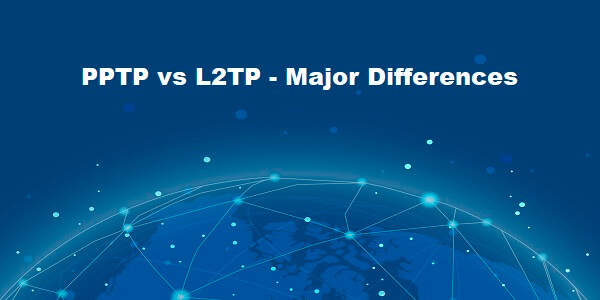
PPTP being the first ever VPN protocol supported by Windows has a basic encryption, but entails to fast internet speed. L2TP, on the other hand, has the highest-level of encryption but produces slower internet speed. If streaming your priority, then PPTP seems a best option, but if keeping your online identity private, then you need to get L2TP.
To know more about these VPN protocols i.e. PPTP vs L2TP, then continue reading.
Difference between PPTP and L2TP
Here is a quick difference between the two protocols based on multiple factors:
| Factors | PPTP | L2TP |
|---|---|---|
| Supported Devices | Compatible with all devices i.e. Windows, Mac, Linux, Android, iOS, Routers, etc | Also compatible with different devices like Windows, Mac, Android, Linux, iOS, Routers. |
| Encryption | 128-bit encryption | 256-bit encryption |
| Stability | Pretty unstable when compared with L2TP, but works with Wi-Fi hotspots | Very much stable and works on every device, networks and platform. |
| Speed | Faster speed | Slower speed |
| Usage | It can be used with an in-built client, username and password, and server address | It is used on a VPN client, username and password, server address, and pre-shared key. |
| Security | Not much secure because it has basic encryption | Very much secure because it completely encrypts your data with strong encryption. |
What is PPTP Protocol?
PPTP (Point-to-Point Tunneling Protocol) is a process of creating a virtual private network. This protocol facilitates the creation of a virtual link between your computer/device and the server tunneling all your traffic to your preferred location. Point-to-Point Tunneling Protocol is more rigid a sophisticated as compared to its antecedent (PPP).
The virtual private network formulated using PPTP accompanies more secure transmission in form of encapsulated data packets where the protocol’s operation is facilitated by GRE tunnel and TCP. One of the reasons for the wide acceptance of Point-to-Point Tunneling Protocol is its compatibility with diverse operating systems.
However, it is mostly preferred by those who run Windows as compared to others preferring Linux or Mac. The reason for this is probably connection speed as PPTP performs better on Windows as compared to other platforms. A virtual private network formulated using Point-to-Point Tunneling Protocol is secure; however, there other protocols that offer more security as compared to PPTP.
Advantages of PPTP Protocol
There are certain characteristics that make PPTP a more frequently adopted protocol as compared to L2TP. These are:
- PPTP was the first formally recognized VPN protocol
- It is compatible with diverse platforms such as Windows, Max and Linux.
- When you create a virtual private network, your actual Internet speed is affected. Point-to-Point Tunneling Protocol has minimal effect on your Internet speed as compared to other protocols such as L2TP.
- PPTP is much easier to use as compared to L2TP. Setting up a virtual private network through Point-to-Point Tunneling Protocol is a complete hassle free process.
- While establishing a virtual private network using PPTP, IPSec encryption isn’t required. Hence, PPTP doesn’t require Public Key Infrastructure (PKI) or computer certificates to be installed while establishing a virtual private network.
- Windows support PPTP by default allowing you to flee from the hassle of configuration.
Disadvantages of PPTP
Along with several advantages associated with Point-to-Point Tunneling Protocol, there are some disadvantages that need to be listed here.
- PPTP surely is compatible with diverse platforms. However, its performance is best suited with Windows as Linux and Mac users may face speed or connectivity issues.
- Point-to-Point Tunneling Protocol uses 128-bit encryption only. This enhances your security to some extent; however, cyber-goons with their sophisticated tricks and tools will easily decode the encrypted files.
- Your key can be extracted by using browser add-ons such as ‘FireSheep’ if you are using PPTP.
- For a secure virtual private network, at least 256-bit encryption is required.
- Lack of IPSec encryption unlike L2TP leaves your security vulnerable when using Point-to-PPTP.
- PPTP accompanies a lack of data origin verification; hence, it cannot detect data alteration in transit or verify the source authenticity.
- PPTP often encounters performance issues on unstable networks which is not the case if you use L2TP.
What is L2TP Protocol?
L2TP or Layer-to-Tunneling protocol that supports virtual private networks just like PPTP; however, the security associated with this protocol is much more sophisticated. L2TP uses a complex encryption protocol known as IPSec. L2TP cannot encrypt your data on its own – it encrypts your data via IPSec protocol and facilitates your privacy.
Layer-to-Tunneling Protocol is often preferred by security-conscious people. Just like PPTP, L2TP supports a virtual private network that tunnels your data but with additional security. L2TP is an answer to different paranoia such as Internet security, privacy, identity theft, and copyright infringement. Furthermore, L2TP represents 256-bit encryption that takes your data security to the next level and makes it invulnerable to unauthorized access.
Advantages of Layer-to-Tunneling Protocol (L2TP)
There are different advantages associated with Layer-to-Tunneling Protocol that proves it to be a better alternative as compared to PPTP.
- Layer-to-Tunneling Protocol offers data encryption through IPSec protocol. IPSec protocol maximizes your security and prevents all unauthorized access.
- L2TP just like PPTP is compatible with different platforms such as Windows, Mac, and Linux.
- L2TP offers almost everything that PPTP does along with value-added security privileges.
- Layer-to-Tunneling Protocol authenticates data origin along with its integrity – this is something PPTP doesn’t offer.
- Unlike PPTP, Layer-to-Tunneling Protocol can be easily configured with some firewalls as it uses UDP to encapsulate data.
Disadvantages of Layer-to-Tunneling Protocol (L2TP)
Along with different advantages, there are several disadvantages of using L2TP that you need to consider as well.
- Due to double encapsulation process of the data, L2TP functionality may wear down with some firewalls.
- The thing most of you would hate about L2TP is that it requires PKI along with other computer certificates to be configured.
- Some versions of Windows such as Vista and Server 2008 might instruct you to change registry settings prior configuration of L2TP.
- Layer-to-Tunneling Protocol has a substantial impact on your Internet speed and deteriorates it a bit more than PPTP.
Conclusion
VPN tunneling protocol serves many different purposes, similar to how a reliable VPN is used for many different reasons. If security is your first priority, then you must connect to L2TP, but if streaming is your interest, then PPTP should be your preferred choice due to its fast speed.
The guide details the characteristics of PPTP vs L2TP which are the two main protocols of a VPN. One of the major advantages of PPTP is the ease of use and minimal effect on internet speed; however, the flaw observed is that it provides minimal security. L2TP on the other hand provides enhanced security with 256-bit encryption but has a significant impact on Internet speed.
People who use a VPN mainly to bypass geo-restrictions in order to watch their favorite TV shows, movies and access other content prefer PPTP due to its speed. Nevertheless, L2TP encryption is often preferred by security freaks due to IPSec protocol which facilitates rigid encryption.
